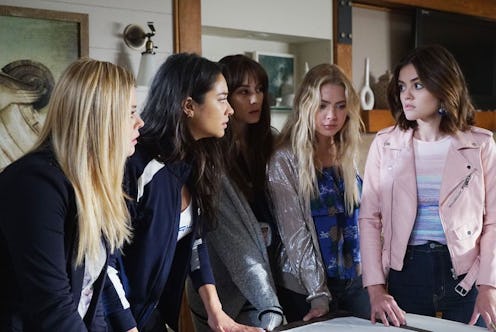
If there's one thing I hate, it's people dismissing anything — media, music, books, whatever — solely because young women like it. Just because the female population enjoys a particular form of entertainment, that doesn't mean it’s somehow less valid. That’s why I liked Pretty Little Liars so much. The series certainly was targeted at a young female demographic, but it never spoke down to its audience. That's why, in my opinion, you should never call Pretty Little Liars a “teen” show.
While there was plenty of fun and froth on Pretty Little Liars, the show treated its characters with the respect that not all shows do. Sure, they are teenagers (at least before the time jump), but they have adult feelings and, especially in the case of the Liars, they definitely have adult problems.
Aria, Spencer, Emily, Alison, Hanna, and Mona were never one-dimensional characters. When the show started, it may have seemed like each fulfilled a certain stereotype — the brain, the jock, the popular girl, the wannabe — but each was so much more complicated than those labels, and banding together was what made them stronger. Spencer was the brain with the analytical side, but she was at her best when she allowed herself to be emotionally vulnerable. Hanna was deemed the "ditz," and although she didn’t know how to pronounce the word gazebo (she called it “gaze-bow”), her brains got the Liars out of some tough spots.
Pretty Little Liars also blew open doors when it came to normalizing representation. When Emily came out as a lesbian, I wondered how the show would handle this plot. Would she be a gay showpiece? Or would her relationships get ignored entirely? The answer was neither — Emily and her relationships were treated just like any of the other relationships on the show. She had problems and heartache and make outs and breakups; she made plenty of mistakes, just like all the other Liars.
Charlotte DiLaurentis — Alison’s cousin and Spencer’s sister (the family tree is complicated) — was transgender, yet this was less shocking than the revelation that she was A. The show made her gender identity just another piece of her story. That’s what Pretty Little Liars was good at — taking people's varying identities and treating them like everyone else. Emily was smart and strong and stupid and loving. Charlotte was vicious and vulnerable and keen and wanting of love. They were just people. There was no other-ing on Pretty Little Liars.
It's also worth remembering the fact that Pretty Little Liars never spoke down to its audience. For a show aimed at teens, the storylines got dark, twisted, and very weird — and still, the show pressed on. Audiences kept coming back because they understood what was happening and didn’t shy away from any subjects, showing that it’s important to not dismiss what an audience can handle because you think they’re too young, or that your show isn’t the right market.
What Pretty Little Liars proves is that you can’t judge a book by its cover. A show that looked like a silly, mindless drama ended up being one of the most socially progressive shows of its day, as well as something both teens and adults could enjoy.